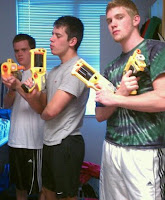-->
 After hearing rumors of the zombie uprising,
Wallentine joined the human forces to fight against the undead.
After hearing rumors of the zombie uprising,
Wallentine joined the human forces to fight against the undead.
With every passing hour Ryan Wallentine’s chances
of survival are dwindling.
But Wallentine, a human in the zombie apocalypse
that has taken over Utah State University’s campus, has a plan to
survive. And he’s not alone.
Humans are using a variety of tactics to stay
alive. Some stay indoors and hide from the conflict. Others prefer direct
confrontation to fight off the zombies.
 After hearing rumors of the zombie uprising,
Wallentine joined the human forces to fight against the undead.
After hearing rumors of the zombie uprising,
Wallentine joined the human forces to fight against the undead.
“I was walking around campus and heard that the end
was near, that the zombies were coming,” he said. “Naturally I was a little
concerned.”
But when the bloodletting began, Wallentine’s
response was more flight, less fight.
“I’ve just tried to avoid and starve the zombies,” said
Wallentine, who does not carry weapons or seek out zombies to fight like many
of his fellow humans. “I don’t go around asking for it. Some people carry
around giant guns that just call ‘come and kill me.’ ”
Jake Hadley, another surviving human, prefers a
different approach.
“It’s more
of an advantage to have the guns rather than lay low,” he said. “My guns just
saved me two minutes ago. Without them I would be a zombie right
now.”
Craig Poulsen, who led a battle against the zombies,
agreed with Hadley. He felt that direct confrontation with the
zombies was a better tactic.
His method was tested in a battle outside the
library when he faced a horde of more than 40 zombies. “I feel like I have a
good chance of survival,” Poulsen said moments before he was turned undead.
Wallentine’s plan to avoid the zombies rather than
confront them had kept him alive through Wednesday morning, though it hasn’t
prevented all encounters with the undead.
“On Tuesday I was leaving the Business
Building and saw two zombies coming so I ran to a parking lot,” he said.
“But then two other zombies came out from behind a car and another from
the Engineering Building. Luckily I managed to get to Merrill
Hall in time.”
Wallentine’s biggest concern is that the zombies
will collaborate with each other to ambush him. “There is definitely some
paranoia,” he said. “I’m looking over my shoulders all the time.”
Wallentine advises other humans to be on the
lookout. “Stay alert,” he said. “If you see a zombie, either be a really good
shot or run like hell.”
The zombie numbers are growing each day. Tuesday
night the zombie horde totaled 229 undead. Wednesday morning its numbers had
grown to 298.
“It’s exciting for me, there are a lot more zombies
now,” Wallentine said. “I’m pretty darn sure it’s going to get harder and
harder but it’ll make my job more interesting.”
UnDeadline
reporters Sarah Menlove, Bradley Wells, Christopher Farnes, Hannah Romney,
Ronald Henline
contributed to this article.








